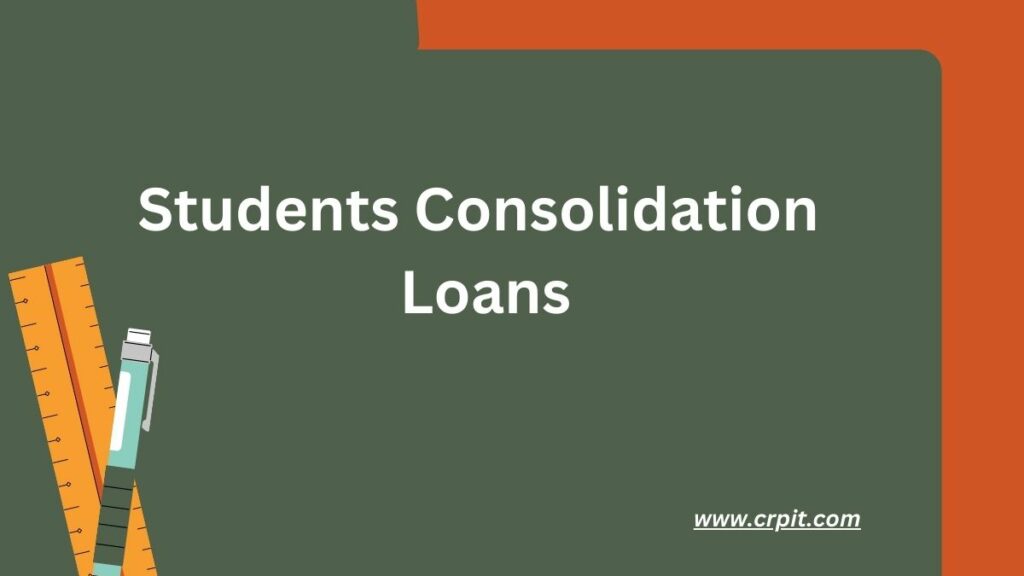Student Loan Consolidation: Student Consolidation Loans give many parents’ or student loan debts from different lenders into a single and larger loan that is later utilized to settle the due amount on the original liabilities.
Additionally, they offer the opportunity for alternate repayment options, which ease the burden of monthly installments. The widespread nature of these loans, comprising Stafford, FISL, SLS, Perkins, Health Professional College Loans, HEAL, NSL, etc., are eligible for student loan consolidation.

Several institutions also provide unique education loan consolidation mortgages. Personal consolidation loans are offered by several creditors, which also include reputed creditors.
Table of Contents
About Students Consolidation Loans
Student debt repayment can be made potentially affordable by consolidating them. You aggregate the whole of existing student loans, obtain a sizable loan modification, and use that money to pay the whole fee.
You are now only required to make one monthly payment to a single provider. Each semester of college, the average student debtor gets funding via federal student loan schemes. It’s not uncommon to present loans to 8 to 10 loan providers even by the time you finish college because they come from several creditors.
Whenever you take loans for higher education in the future, include 4 to 6 more lenders. The following college loans seem to have different funding schedules, costs of borrowing, and due dates.
Need to Consolidate Student Loans
Student Loan Consolidation is frequently an option for federal student loans. In contrast, debtors of government and private lenders are eligible for refinancing. Consolidating loans can cut and simplify monthly bills for students.
Additionally, it’s a fantastic method to have a direction toward more repayment options and consumer safeguards, repair a failed loan, or lessen the pressure of debt repayments.
- Reduced monthly obligations: The monthly amount will be less after consolidating all student loans and extending the repayment duration to a maximum of 30 years. But remain aware that over time, your debt amount interest rate will increase.
- Optimized payments: Integrating student loans might make it easier for you to finish off just one debt unless you’re presently paying the amount to many providers.
- Additional choices for payback and client security: Borrowers who consolidate their federal student loans have access to a variety of income-driven. Additionally, by combining their federal debts into a single loan, students who wouldn’t otherwise be eligible to seek Public Service Loan Forgiveness.
- An additional loan creditor: Consolidating your student debt allows you the freedom to select a different servicer since you’re experiencing issues with your existing one. You will be required to choose a creditor for a new loan after submitting the consolidation request.
- A different approach from debt rehabilitation: Debt consolidation might aid you in paying off college debt that seems to be currently under default, regardless of whether you accept to settle the credit facility on such an IDR program or complete three options, on-time, including entire monthly bills on a promissory note prior to merging it.
Also Read-
- Federal Student Loans
- Loans For Students: How To Fund Your Higher Education In US And Australia?
- 25 Highest Paying Jobs ($100K+) Without A Degree
- Best Tuition Free Colleges In The United States For 2024
- The 12 Most Generous Universities For Financial Aid
Student Loan Consolidation Procedure
Students must keep paying off their current debts till the consolidating grant is released because the application procedure ends up taking less than 30 minutes, while clearance may take up to 90 days. For combining federal education loans, check out the procedure:
- Since you need an FSA profile to seek federal financial assistance, you have the login information. Simply log into StudentAid.gov, click the link “Manage Loans” and afterwards tap “Consolidate My Loans” present in the menubar to begin the process.
- Gather the data required to finish the request and loan agreement, such as your college loan data and individual income details, prior to starting the consolidation procedure. You can obtain every information about federal loans if you’re submitting an online application.
- Decide on Credit & Servicer: The new suitable financing and rate of interest are calculated when you choose the loan to combine during the initial part of the credit application. Additionally, you’ll pick a loan provider and ask for a grace duration from there.
- Select Repayment: Options for repaying federal student debt rely on the types of borrowings you’re combining and the economic state. Considering your earnings, household size, and tax liability, this component estimates your expected repayments. Before continuing to the application’s next phase, you will be required to select a payback strategy.
- Guidelines & Regulations: The Lender Conceptions, Certifications Permissions, etc., are contained inside this part of the request.
- Identifying information: Fill out all your info here, containing your driver’s license number, residential address, phone number, and employment. Add the phone numbers and names of two known individuals after that.
- Analyze & Confirm: Evaluate the application after it has been finished, certify that every bit of content is reliable and valid, including you are aware of such repayment terms, and sign.
If you have any inquiries concerning the progress of the claim once you’ve submitted it, get in touch with the servicer you choose. The phone numbers for their creditor are provided to candidates there at the end of the application procedure; for hardcopy registrants, it is provided after users print their form.
Depending on the monthly payment you chose for the online application, your monthly rate and timeline will be decided. Although debtors typically have a maximum of 60 days of granting loans & to start paying, the mortgage provider will approach you regarding the repayment plan and the timing of the initial installment.
Important Links
FAQ’s
Are consolidated loans eligible for forgiveness?
You might well be able to obtain forgiveness alternatives, including income-driven payback or public utility debt forgiveness, assuming you combine debts besides Direct Grants.
Will my interest rate change if I consolidate my student loans?
By lengthening the repayment period, consolidation might reduce your installments. However, the cost of your interest may rise.
What are the dangers of student loan consolidation?
Harm to credit history, a chance of receiving interest rates that are too high, as well as the possible failure of all security and a few major hazards involved with loan consolidation.
